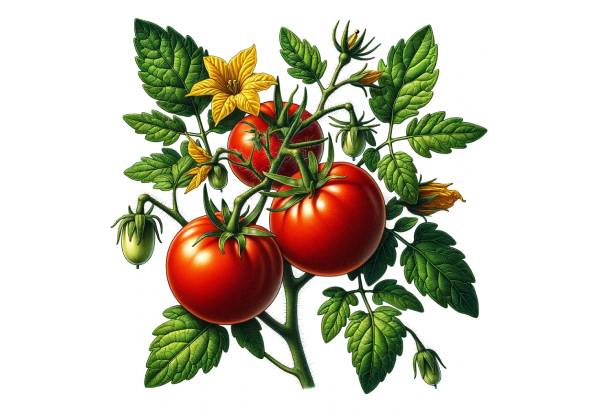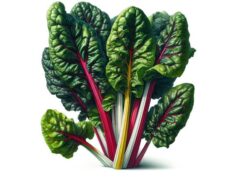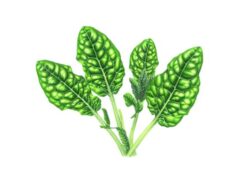
Introduction to Tomatoes
Tomatoes, scientifically known as Solanum lycopersicum, are one of the most popular and versatile fruits worldwide. Tomatoes were originally native to western South America before being domesticated in Mexico and spreading around the world following Spanish colonization of the Americas. Tomatoes are now a common ingredient in many cuisines, celebrated for their rich flavor and nutritional value.
Tomatoes come in a variety of shapes, sizes, and colors, including small cherry tomatoes and large beefsteak varieties, as well as red, yellow, orange, and even purple. They are edible raw, cooked, or processed into sauces, pastes, and juices. Their culinary versatility makes them an important part of many people’s diets around the world.
Beyond their culinary appeal, tomatoes are known for their numerous health benefits. They contain essential nutrients and bioactive compounds that promote overall health. Tomatoes have long been associated with cardiovascular health, cancer prevention, and anti-inflammatory properties. Modern research is revealing the wide-ranging health benefits of tomatoes, including their beneficial effect on eye health. Tomatoes are especially beneficial for maintaining and improving vision because they contain high levels of vitamins A, C, and E, as well as the powerful antioxidant lycopene.
Nutritional Profile of Tomato
Tomatoes are a nutritional powerhouse, containing a variety of vitamins, minerals, and antioxidants that benefit overall health, particularly eye health. Here’s a detailed breakdown of the main nutrients found in tomatoes:
- Vitamin A: Tomatoes contain a lot of vitamin A, primarily in the form of beta-carotene. One medium-sized tomato contains approximately 20% of the daily recommended intake of vitamin A. This vitamin is essential for maintaining clear vision, boosting immune function, and improving skin health.
- Vitamin C: This potent antioxidant is abundant in tomatoes. One medium tomato provides approximately 28% of the daily recommended intake of vitamin C. This vitamin protects the eyes from free radical damage and promotes the health of ocular blood vessels.
- Vitamin E: Tomatoes contain a high concentration of vitamin E, another powerful antioxidant. It protects eye cells from damage and promotes overall eye health. A medium tomato provides about 5% of the daily recommended intake.
- Vitamin K: Tomatoes contain vitamin K, an essential nutrient for blood clotting and bone health. A medium tomato provides approximately 8% of the daily recommended intake.
- Lycopene: Lycopene is the most health-promoting nutrient in tomatoes. Lycopene, a powerful antioxidant, gives tomatoes their red color. It has been extensively studied for its potential to reduce the risk of chronic diseases, such as cataracts and age-related macular degeneration (AMD).
- Potassium: One medium tomato contains approximately 6% of the daily recommended amount of potassium. This mineral regulates blood pressure, balances fluids, and promotes muscle and nerve function.
- Folate (Vitamin B9): Tomatoes contain an adequate amount of folate, which is required for DNA synthesis and repair. One medium tomato provides approximately 5% of the daily recommended intake.
- Fiber: Tomatoes are high in dietary fiber, which helps with digestion and promotes a healthy gut microbiome. One medium tomato contains approximately 1.5 grams of fiber.
In addition to these essential nutrients, tomatoes contain a number of bioactive compounds that contribute to their health benefits.
- Beta-Carotene: This carotenoid is converted by the body into vitamin A, which is required for good vision.
- Lutein and Zeaxanthin: These carotenoids are abundant in the retina and help prevent age-related macular degeneration (AMD) and cataracts.
Why Tomatoes are Good for Eyes
Tomatoes are high in vitamins, carotenoids, and antioxidants, which contribute to their numerous eye health benefits. Here, we’ll look at how tomatoes can help and improve your vision.
High levels of lycopene
Lycopene is one of the strongest antioxidants found in tomatoes. It protects the eyes from oxidative damage and lowers the risk of chronic eye diseases.
- Oxidative Stress Reduction: Lycopene neutralizes free radicals, which reduces oxidative stress in the eyes. Oxidative stress plays a significant role in the development of age-related eye conditions like cataracts and AMD. Lycopene protects the eyes from oxidative damage, which helps to maintain clear vision.
- Anti-Inflammatory Properties: Chronic inflammation can promote the development of eye diseases. Lycopene has strong anti-inflammatory properties that help reduce inflammation in the eyes, providing additional protection against conditions such as AMD.
Role of Vitamin A
Vitamin A is essential for maintaining good vision, especially in low-light situations. Tomatoes contain beta-carotene, which the body converts into vitamin A.
- Rhodopsin Production: Vitamin A is a component of rhodopsin, a protein in the eye that absorbs light via retinal receptors. This is especially important for seeing in low light conditions. Consuming tomatoes promotes adequate rhodopsin production, which improves overall visual acuity.
- Corneal Health: Vitamin A helps to maintain a healthy cornea, the eye’s outermost layer. It helps to keep the cornea moist, lowering the risk of dry eye syndrome and other corneal conditions.
Antioxidant Properties of Vitamins C and E
Tomatoes are high in vitamin C and E, both of which have strong antioxidant properties. These vitamins help protect the eyes from free radical-induced oxidative damage.
- Vitamin C: This powerful antioxidant protects the eyes from oxidative damage and promotes the health of the ocular blood vessels. It also helps to regenerate other antioxidants, such as vitamin E, which increases their effectiveness.
- Vitamin E: Protects cell membranes from oxidative damage and promotes overall eye health. Studies have shown that vitamin E can lower the risk of cataracts and slow the progression of AMD.
Reducing the risk of age-related macular degeneration (AMD)
AMD is the leading cause of vision loss among older adults. Tomatoes contain carotenoids lutein and zeaxanthin, which are particularly effective at protecting against AMD.
- Macular Pigment Density: A higher dietary intake of lutein and zeaxanthin raises the density of macular pigment, which protects against harmful light and oxidative stress. This lowers the risk of developing AMD.
- Anti-inflammatory Properties: Chronic inflammation is a risk factor for AMD. Lycopene, lutein, and zeaxanthin have anti-inflammatory properties that help reduce inflammation in the retina, providing additional protection against AMD.
Cataract Prevention
Another leading cause of vision impairment is cataracts, which are defined as clouding of the eye’s lens. Antioxidants, such as vitamins C and E, as well as lycopene, help to prevent cataract formation.
- Oxidative Stress Reduction: These antioxidants help to reduce oxidative stress in the lens, which prevents cataract formation. By neutralizing free radicals, they keep the lens clear and promote healthy vision.
Improves Overall Eye Function
Beyond protecting against specific diseases, the nutrients in tomatoes help with overall eye function and health.
- Vitamin A for Corneal Health: Vitamin A helps to maintain a healthy cornea, lowering the risk of dry eye syndrome and other corneal conditions.
- Vitamin C for Blood Vessel Health: Vitamin C promotes the health of ocular blood vessels by ensuring adequate oxygen and nutrient delivery to eye tissue.
- Vitamin E for Cell Membrane Protection: Vitamin E protects the cell membranes in the eyes from oxidative damage, which promotes overall eye health.
Anti-inflammatory Effects
Chronic inflammation can promote the development of eye diseases. Tomatoes contain several anti-inflammatory compounds, including lycopene, lutein, and zeaxanthin, which help to reduce inflammation in the body. Tomatoes can indirectly benefit eye health by reducing systemic inflammation and the risk of inflammatory eye conditions.
Maintaining Healthy Blood Vessels
Tomatoes contain potassium, which helps regulate blood pressure and keep blood vessels healthy. Proper blood flow is critical for delivering nutrients to the eyes and eliminating waste. Tomatoes promote good eye health in addition to cardiovascular health.
Tomatoes, with their high concentration of nutrients and bioactive compounds, play an important role in maintaining and improving eye health. Regular consumption of this versatile fruit can help protect against a variety of eye conditions, maintain good vision, and improve overall eye function.
Best Ways to Enjoy Tomatoes
To reap the most eye health benefits from tomatoes, consume one to two medium-sized tomatoes (approximately 200-300 grams) per day. This amount ensures that you receive an adequate supply of essential vitamins, antioxidants, and carotenoids required for healthy vision.
Here are some simple and delicious recipes for incorporating tomatoes into your diet:
- Tomato Salad: Mix chopped tomatoes, fresh mozzarella, basil leaves, and a drizzle of balsamic vinegar and olive oil. Season with salt and pepper to taste.
- Tomato Soup: Sauté onion and garlic in olive oil, then add chopped tomatoes, vegetable broth, and a bay leaf. Simmer until the tomatoes are tender, then purée until smooth. Season with salt and pepper, and if desired, add a touch of cream.
- Tomato Pasta: Cook your favorite pasta according to the package directions. In a pan, cook the garlic and cherry tomatoes in olive oil until the tomatoes blister. Toss in cooked pasta, fresh basil, and grated Parmesan cheese.
- Tomato Bruschetta: Toast baguette slices, rub with garlic, and top with diced tomatoes, basil, olive oil, and balsamic vinegar.
When choosing tomatoes, look for those that are firm, brightly colored, and free of blemishes. To store tomatoes, keep them at room temperature and out of direct sunlight until they are completely ripe. Once ripe, refrigerate them to extend their shelf life, but let them come to room temperature before eating to get the full flavor. Before beginning, wash the tomatoes under cold running water to remove any dirt or residue.
Trusted Resources
Books
- “The Tomato: From Market to Dinner Table” by Lawrence Davis-Hollander – This book explores the history, varieties, and nutritional benefits of tomatoes, along with delicious recipes.
- “Tomatoes: A Savor the South Cookbook” by Miriam Rubin – A comprehensive guide to cooking with tomatoes, including their health benefits and a variety of recipes.
- “Superfoods: The Healthiest Foods on the Planet” by Tonia Reinhard – This book covers various superfoods, including tomatoes, detailing their nutritional benefits and how to incorporate them into your diet.
Reliable Sources and Studies
- National Center for Biotechnology Information (NCBI): Lycopene and Eye Health – This study explores the benefits of lycopene, particularly in relation to eye health.
- National Institutes of Health (NIH): Vitamin A and Eye Health – Detailed information on the importance of vitamin A for eye health and its role in preventing vision problems.
- American Academy of Ophthalmology: Nutrition and Eye Health – This article discusses various nutrients, including those found in tomatoes, that are beneficial for eye health.
- Harvard T.H. Chan School of Public Health: The Nutrition Source: Vegetables and Fruits – This resource provides an in-depth look at the health benefits of vegetables and fruits, including tomatoes, and their role in maintaining eye health.
- Journal of the American College of Nutrition: The Impact of Antioxidants on Eye Health – A study examining the effects of antioxidants found in tomatoes on eye health and the prevention of age-related eye diseases.
- World’s Healthiest Foods: Tomatoes – Comprehensive information on the nutritional profile of tomatoes and their health benefits, including their positive impact on eye health.










